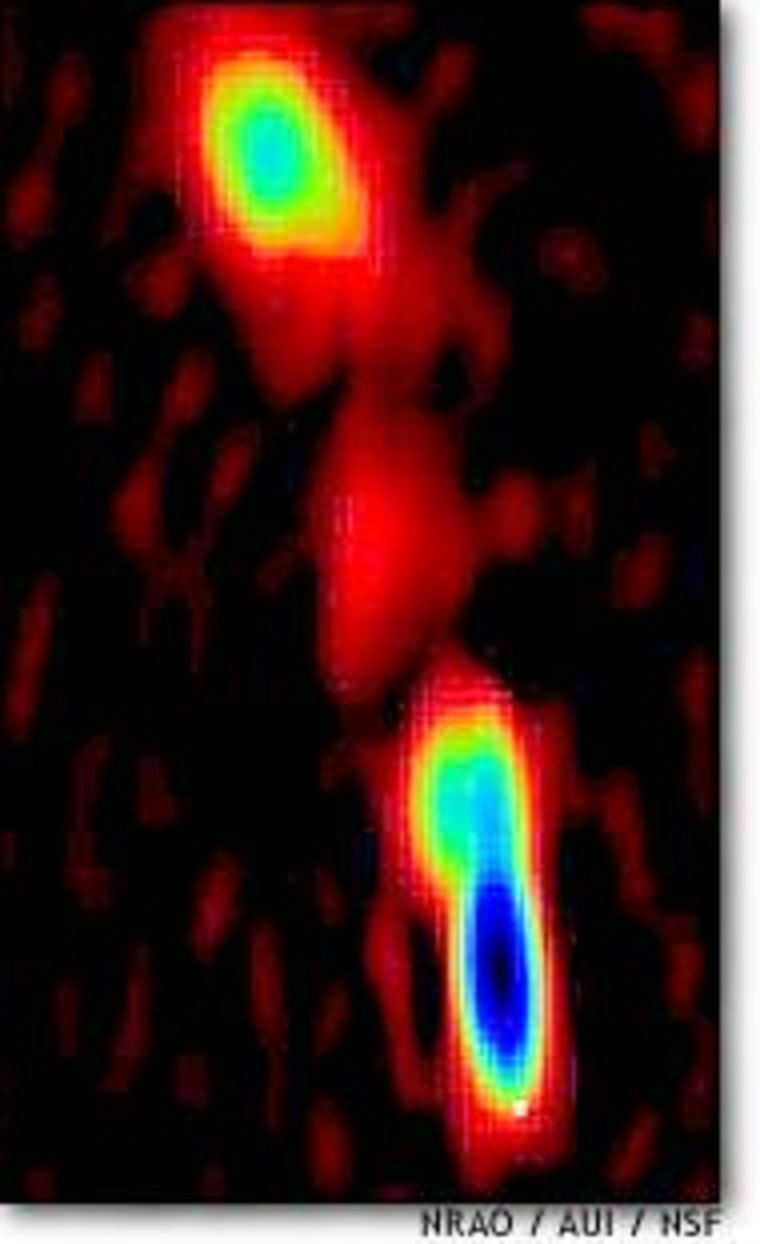Albert Einstein can rest a little easier: The first effort to measure how quickly gravity exerts its influence indicates that it more or less matches the speed of light, scientists reported Tuesday. If the results had come out differently, it would have cast new doubt on Einstein’s view of general relativity — and in fact, some doubters contend that the latest measurement by no means closes the case.
The measurement, presented at this week’s meeting of the American Astronomical Society in Seattle, was made by analyzing how radio waves from a quasar nearly 9 billion light-years from Earth were bent as they passed through Jupiter’s gravitational field on Sept. 8.
Scientists have known for decades that gravity bends waves of electromagnetic radiation: The phenomenon played a key role in the first test of general relativity during a 1919 solar eclipse.
But it’s only been in the last few years that astronomers have worked on putting a number to the propagation speed of gravity’s effect. This speed is distinct from the much better-known rate of acceleration caused by gravity on Earth, which clocks in at 32 feet per second per second.
The classic illustration of the problem goes this way: Imagine that the sun were somehow snuffed out of existence in the blink of an eye. Would there be an instant disruption in Earth’s orbit, sending it careening out of the doomed solar system, or would Earth continue to orbit a nonexistent star for eight minutes while the gravitational disturbance traveled 93 million miles (150 million kilometers) at the speed of light?
“Newton thought that gravity’s force was instantaneous,” Sergei Kopeikin, a physicist at the University of Missouri at Columbia, said in an written announcement of the results. “Einstein assumed that it moved at the speed of light, but until now, no one had measured it.”
Kopeikin’s partner in the research, Ed Fomalont of the National Radio Astronomy Observatory, said the propagation speed was equal to the speed of light within an accuracy of 20 percent. That may sound like a wide error margin, but the researchers said they were pleased with the results.
“Our main goal was to rule out an infinite speed of gravity, and we did even better,” Fomalont said in the announcement. “We now know that the speed of gravity is probably equal to the speed of light, and we can confidently exclude any speed for gravity that is over twice that of light.”
If gravity does propagate even 20 percent faster than light, it would break a cosmic speed limit imposed by Einstein’s theories — and could hypothetically open the way to new methods of faster-than-light communication (hopefully on a smaller scale than snuffing out the sun).
How it was done
The experiment was conducted by carefully charting how radio waves from the quasar, J08421835, were distorted in the night sky as Jupiter passed through the field of view. In 1999, Kopeikin laid out what Einstein’s theory should predict about the pattern of distortion — then found that September’s “once-in-a-decade” alignment should allow for a test of the theory.
He turned to Fomalont, who enlisted the aid of the National Science Foundation’s Very Long Baseline Array, a continent-wide network of radio telescopes. A 330-foot (100-meter) radio telescope in Effelsberg, Germany, was added to the network to increase the accuracy of September’s observations.
“We had to make a measurement with about three times more accuracy than anyone had ever done, but we knew in principle that it could be done,” Fomalont said. Sunspot activity during the observations gave the researchers some cause for concern, but in the end, the data achieved a precision equal to the width of a human hair seen from 250 miles (400 kilometers) away, the researchers said.
If the speed of gravitational propagation were infinite, the apparent position of the quasar should have moved in a perfect circle due to the bending of the radio waves, Kopeikin said. Instead, it inscribed an offset ellipse, shaped roughly as would be expected if the speed of gravity and the speed of light were equal.
What it all means
Kopeikin said the observation sheds light on one of the last unsettled fundamental constants of physics — and could play a role in the continuing quest to develop a “theory of everything” that unites gravitational theory and quantum mechanics.
“Our measurement puts some strong limits on the theories that propose extra dimensions, such as superstring theory and brane theories,” he said. “Knowing the speed of gravity can provide an important test of the existence and compactness of these extra dimensions.”
Commenting on the research, University of Washington cosmologist Craig Hogan said it was almost a given among mainstream theorists that the speed of gravity should equal the speed of light. But he agreed that the experiment would be useful in plotting the future course for extradimensional physics. “The frontiers of physics are very much concerned with small departures from Einstein’s theories of space and time and gravity,” he said.
Not all physicists are convinced that the results truly measured the propagation speed, however. In Astrophysical Journal Letters, Japanese physicist Hideki Asada argued that the experiment actually measured the speed of light rather than the speed of gravity.
Kopeikin, who submitted his own paper to the Astrophysical Journal Letters late last month, said at Tuesday’s news briefing that Asada’s argument was incorrect. “He made a mathematical mistake,” Kopeikin said.
Astronomer Thomas Van Flandern, who has built up a following for his views outside the scientific mainstream, said in a September commentary that the experiment may have measured the speed of gravitational waves, but “can provide no information about the propagation speed of gravitational force, which is bounded by many experiments to be much faster than light.”
